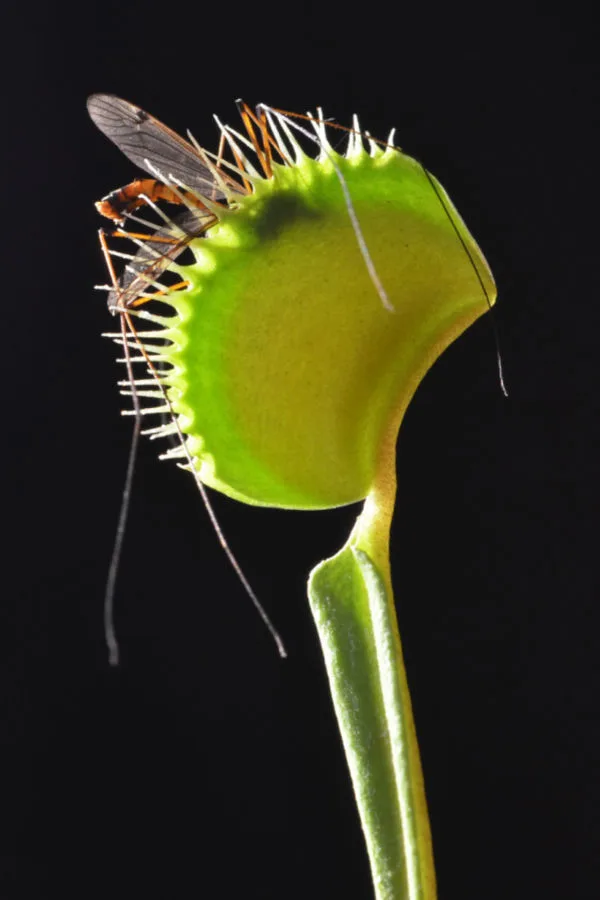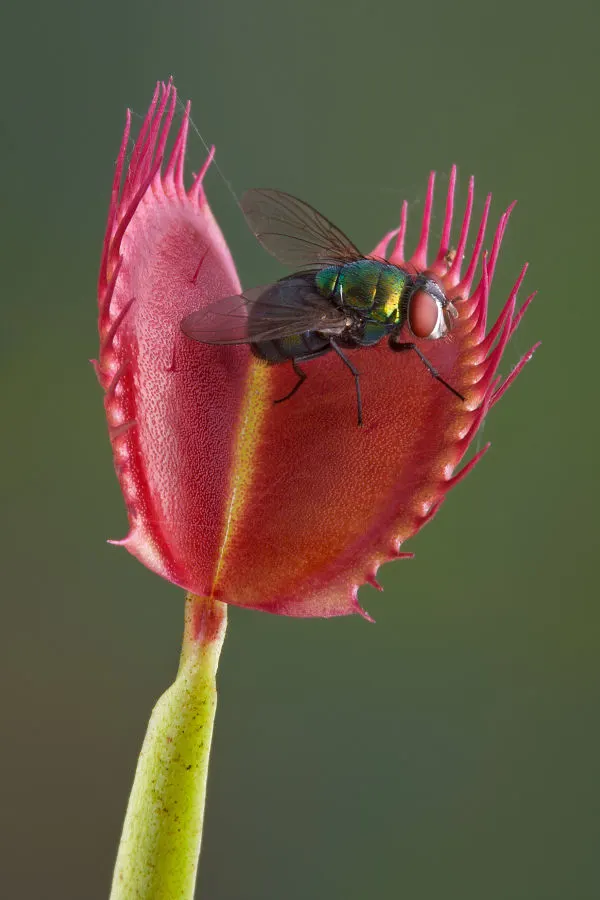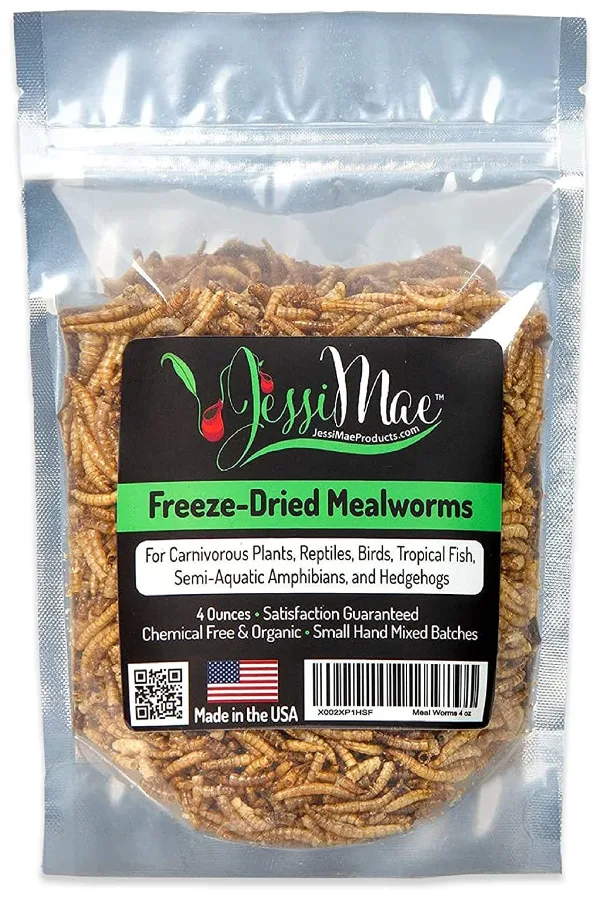If you are looking for an incredibly unique houseplant to grow indoors, consider growing a Venus fly trap plant – the houseplant with an appetite for much more than basic fertilizer!
Not only will the distinct foliage of this insect trapping plant add a touch of interest to your interior space, the fact it can trap and consume flies and mosquitoes will have visitors begging for a demonstration every time they visit!
Venus fly trap plants have long been a hit with children and adults alike. In fact, who can’t remember their science or biology teacher demonstrating the carnivorous plant to their class back in the day. It was simply fascinating to watch the plant’s jaw-like leaves close around its prey!

The plant truly is unique in how it obtains its food. Most plants absorb nutrients through their roots, stems and leaves. But the fly trap plant instead prefers insects. And how it attracts and consumes its prey is exactly what makes it such a showstopper to grow indoors as a houseplant.
With all of that in mind, here is a look at how to grow your own amazing Venus fly trap plant at home. We have also included a section below on the best ways to “feed” your plant, along with a few links on where to find live houseplants for purchase.
How To Grow A Venus Fly Trap Indoors
Temperature, Humidity & Light
Growing the fly trap plant indoors as a houseplant is not difficult. Although its name may make one think it comes from outer space, the plant is actually native to the coastal Carolinas. The name Venus was given to it in honor of its beautiful foliage and tiny white blooms. Bloom which were thought to resemble the planet Venus in the sky at night.
In terms of temperature and humidity, the Venus fly trap does not require special attention. As long as it can grow in a moderately temperate room (65° to 75°F), it will perform well.
When growing indoors, the plant requires typical “sunny room” house plant treatment. For optimum growth, place near a sunny window that receives at least four to six hours of direct light, and ten to twelve hours of indirect light. It can survive in lower light, but the foliage may not be as robust and bright. See: Growing Houseplants
Soil & Water – How To Grow A Venus Fly Trap Indoors
In its native environment, the Venus fly trap grows in slightly acidic soil. Because of this, the plant will not do well when growing in traditional potting soil. These soils are too rich and heavy for the roots of the plant.

Instead, select a soil mix that is heavy with a peat moss base. This will keep the soil low in nutrients and also help it lean to the acidic side. You can create your own mix with peat moss and sand, but there are some good, low cost quality mixes on the market that are designed specifically for these types of plants. Product Link : Carnivorous Soil Mix
When it comes to watering, less is more. The fly trap plant will usually require watering about once every two weeks. The peat moss mix will do a good job of keeping moisture around the roots. But overwatering can oversaturate the roots and can kill the plant in the process.
Before watering, make sure the soil is not wet or dry, but just slightly damp. You do not want the soil to completely dry out between each watering, but instead, be slightly moist.
When watering, do not use city water or treated water from a water softening system. The salts, chlorine and other chemicals in treated water can harm the plant. Instead, water with distilled water or water from a rain barrel.
Feeding Your Plant – How To Grow A Venus Fly Trap Indoors
Now comes the interesting part – how to best feed your Venus fly trap plant! Unlike traditional plants that receive their nutrients from the soil and air, the Venus fly trap needs to literally consume its nutrition from insects. Insects that either land on it and are trapped, or ones you provide.

This is exactly why fertilizing your plant’s soil or leaves is a big no-no. For starters, it will not provide any nutrition to the plant at all. Instead, it will usually create a soil mix that is too rich for the plant, causing its demise.
The leaves of a fly trap are designed with feeding in mind. The plant contains modified leaves that are hinged. There is nectar inside the leaf that attracts insects to land on the leaves. Along with the nectar, there are trigger hairs on the interior of the leaves as well.
When the nectar attracts an insect to land on the hinged leaves, the insect then trips the trigger hairs. When they do, the leaves close around them, trapping them inside. The rest, as they say, is history. The plant then breaks down the food source with enzymes, a process that can take about a week on average.
Once the insect has been consumed, the trap leaves open back up. And just like that, they are ready to attract their next meal. It truly is a fascinating process, and one that makes this plant such an interesting one to grow as a houseplant!
How Often Does A Venus Flytrap Need To Eat?
Although the plant can certainly capture a few flies, mosquitoes and gnats on its own, there is usually not enough available food to keep the plant alive indoors without supplemental feeding. But don’t worry, this doesn’t mean you have to spend your days catching insects!
To grow and stay healthy, the trap leaves on a plant should be fed about every ten to fourteen days. You can certainly “feed” your plant with flies, but most Venus fly trap houseplant owners opt to purchase ready made “food” for their plants.

Freeze dried mealworms are a great option and are easy to keep on hand. Feeding your plants is as simple as placing the mealworms on the trigger hairs with a pair of tweezers. Product Link: Freeze Dried Mealworms – Natural Protein Meal Supplement for Venus Fly Trap Plants
Where To Find A Plant – How To Grow A Venus Fly Trap Indoors
So, the big question is where can you actually find a Venus fly trap houseplant for purchase? You can sometimes find plants at a local plant shop or nursery, but most often, purchasing a live plant or plant kit online is the best option.
- Venus Fly Trap Plant Link: 3″ Potted Venus Flytrap ‘B52’ Carnivorous Plant
Dividing Plants / Long Term Care
The good news is that once you own a fly trap plant, they are easy to divide and split. Older plants will grow small offshoots, usually in the spring. You can then cut these shoots loose and repot them directly into soil to create a new plant.
The Venus fly trap plant will go through a dormancy period, even as a houseplant. This will occur over the winter months when natural light is lower. The plant’s foliage will die back, and will return once again as spring nears and daily light improves.

Continue to water your plant through its dormancy period on a normal schedule. Feeding of course will stop at this point until new leaves can grow. No worries about the plant starving, the plant lives off of the food stored in its roots during this period. Here is to growing your own unique Venus fly trap plant!
Follow Our Facebook Page For Great Gardening Tips And Advice! This Is My Garden Facebook Page
This Is My Garden is a garden website created by gardeners, for gardeners. Jim and Mary Competti have been writing gardening, DIY and recipe articles and books and speaking for over 15 years from their 46 acre Ohio farm. They publish three articles every week, 52 weeks a year. Sign up today to follow via email, or follow along!
